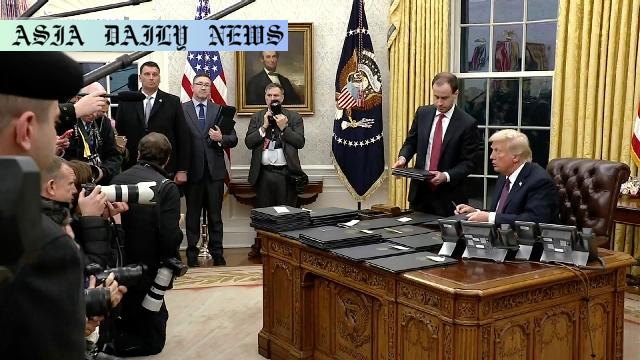Digital Assets: Trump signs an executive order to promote digital assets, highlighting their importance in innovation and economic growth.

Introduction
On Thursday, US President Donald Trump made a significant move in the financial and technological space by signing an executive order designed to promote the use and development of digital assets, such as cryptocurrencies and blockchain technologies. This marks a transformative stance from the US government, recognizing the pivotal role of digital assets in fostering innovation and driving economic development.
What the Executive Order Covers
The executive order directs attention towards the tangible benefits of digital assets in empowering various sectors of the economy. According to the order, blockchain technology and related innovations are capable of creating jobs, generating economic opportunities, and ensuring that the US remains a leader in global technological advancements. Trump’s administration underscores the significance of “responsible growth and use” of these assets, which points towards a balanced approach—encouraging innovation while addressing potential risks.
One of the key components of this executive order includes the establishment of a robust working group under the National Economic Council. This group will play a cornerstone role in analyzing current and future trends and developing a comprehensive set of regulatory and legislative proposals within 180 days. Importantly, the team will include top officials from key government entities, ensuring a spectrum of perspectives and expertise.
Proposed National Digital Asset Stockpile
Among the groundbreaking suggestions is the creation of a national digital asset stockpile. According to the executive order, this stockpile could consist of cryptocurrencies lawfully seized by federal law enforcement, offering the government a potential opportunity to engage with these assets strategically while leveraging them as part of larger financial policy frameworks. The concept is revolutionary in the financial domain, introducing a mechanism for government interaction with these decentralized digital currencies.
A Ban on Central Bank Digital Currencies
While advocating for the promotion of cryptocurrencies and blockchain technologies, Trump’s executive order takes a clear stance in banning Central Bank Digital Currencies, or CBDCs. This decision reflects an ideological preference for the decentralized nature of cryptocurrencies, which aligns with the administration’s broader objectives to deregulate and support private innovation, rather than establishing a government-controlled digital currency system.
Impact on Market Trends
In the wake of this announcement, the digital asset market has seen significant reactions. Bitcoin, the world’s largest cryptocurrency, reached $100,000 shortly after the news broke—a monumental achievement for the industry and a clear indication of how government endorsements can bolster confidence among investors and stakeholders.
Trump’s advocacy of deregulation in the digital asset sector also sends a strong signal to entrepreneurs and businesses looking to innovate within the US. These developments could position the United States as a global leader in the crypto and blockchain landscape, fostering innovation, economic growth, and technological advancement.
The Road Ahead
With the establishment of the working group, stakeholders within the digital asset ecosystem can expect further clarity and guidance on regulatory and legislative developments. The 180-day timeline set forth in the executive order indicates that concrete actions are on the horizon. This is a pivotal moment for the industry as it waits for a structured regulatory framework that aligns public and private sector goals while maintaining a focus on innovation and security.
The outright ban on CBDCs, however, introduces a point of contention. While some view this move as a barrier to federal modernization of the financial system, others applaud it as a pro-innovation stance, positioning private companies at the forefront of digital currency evolution.
Overall, Trump’s executive order on digital assets could significantly shape how industries, governments, and the public embrace this evolving technology. As it unfolds, it provides an opportunity for collaboration and advancement in one of the most dynamic innovations of our time.
Commentary
A Milestone for Innovation
President Trump’s executive order on digital assets stands out as a bold and strategic move in a world increasingly driven by blockchain and cryptocurrency technology. By openly endorsing these innovations, the administration has sent a clear message of support for entrepreneurs, innovators, and technologists who aim to push boundaries in the financial and technological sectors. This is undoubtedly a monumental step for digital economies worldwide.
The Balance Between Innovation and Regulation
One of the fascinating aspects of this order is Trump’s emphasis on “responsible growth and use.” The inclusion of a working group tasked with generating recommendations within 180 days reflects the administration’s awareness of the complexity of this ecosystem. Without proper regulation, the risks of misuse, fraud, or market instability remain significant. However, the administration’s focus on deregulation and innovation within the private sector indicates a willingness to tread carefully without stifling progress.
Opportunities and Challenges
The idea of a national digital asset stockpile is particularly exciting. This concept recognizes the unique challenges of modern economies and allows the government to participate in the crypto landscape in an innovative and potentially profitable way. At the same time, the outright ban on CBDCs raises questions about long-term strategies. Will this decision put the US at odds with other nations developing their own CBDCs?
Conclusion
Overall, this executive order represents an important moment for the digital asset ecosystem in the US. By embracing innovation while ensuring a structured regulatory framework, the Trump administration is laying groundwork to strengthen America’s position as a leader in technological advancements. The road ahead will undoubtedly have its ups and downs, but the possibilities for economic growth and innovation are limitless.


